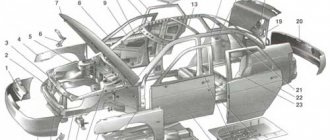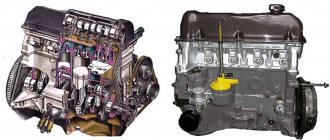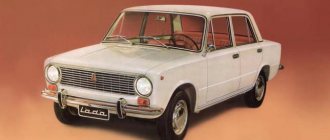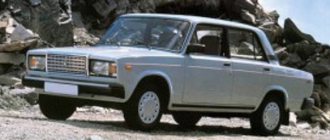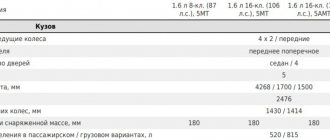VAZ-2106 is a true classic of the Soviet automotive industry. The car was produced for a long time after the collapse of the Union, which is explained by its incredible reliability. In addition, it stands out from other domestically produced cars due to its amazing maintainability of literally every component, availability of spare parts, and unlimited possibilities for modernization.
An important advantage of the VAZ-2106 is the engine used in this car. This four-stroke unit, equipped until 2002 with a carburetor and then with an injection fuel ignition system, can run on even the lowest quality gasoline, rarely fails in extreme cold, and can be operated successfully in almost any conditions. Any of its problems are eliminated even without the participation of a specialist - any more or less experienced car enthusiast can easily cope with routine repairs.
How much does Zhigulevsky weigh?
The Lada Seven, according to documents, has a mass of 1049 kg. However, her weight
practically no different from any other brand of car from the Volzhsky Automobile Plant.
The average weight
of this Soviet car, which is often scrapped, is around one ton.
Hello, my name is Evgeniy Sokolov. Since childhood I have been fascinated by cars, especially how they work
And I received the appropriate technical education. In my blog I write reviews of models, technical characteristics and operating experience of various industrial and agricultural special equipment.
Source
Additional processing measures
It is worth noting that with dimensions of 4.07/1.61/1.44 meters, the car in question has a fairly acceptable weight. The strength and integrity of the body is affected not only by how much a “penny” weighs and how thick the metal is, but also by the quality of factory and independent anti-corrosion treatment.
According to the rules, after welding procedures, before painting, the car body must undergo phosphatization. During this treatment, the entire surface of the frame was covered with a special phosphate film that is resistant to chemical attack. In addition, the effect was secured by applying a layer of primer, which was sprayed using electrophoresis. This allowed the primer to provide even coverage in the most difficult to reach areas. The bottom of the vehicle was treated with a special reinforced mastic, which reliably protects the bottom from the effects of an aggressive environment.
How much does a VAZ classic cylinder block weigh?
VAZ cylinder block sizes: 2103, 2106, 21213, 21214, 2123, 2130.
Applicability - on engines: VAZ-2103, 21043, 21053, 21061, 2107.
What size piston rings for VAZ 2103:
How much does the VAZ 2106 engine block weigh? — Weight — 39,200 kg.
Applicability - on engines: VAZ 2106, 21067, 21074, 2121 Niva.
Applicability - on engines: VAZ 21213, 21073, 21214.
Applicability - on engines: VAZ 21214, 21073, 21213.
Applicability - on engines: VAZ 2123.
Applicability - on engines: VAZ 2130.
All of the above blocks are used on engines that belong to the line of “classical” design engines.
All these cylinder blocks share the same dimensions:
— the distance between the axes of adjacent cylinders, which is 95.00 mm;
— diameter of the bed for the crankshaft supports.
The table shows the main dimensions of VAZ cylinder blocks. (block repair dimensions)
| Cylinder block model | Dc(mm) | H(mm) | Lc(mm) | d(mm) |
| VAZ 2101 * | 76.00 +0,05 | 207.10 -0,15 | 95.00 | 54.52-0,013 |
| VAZ 21011 * | 79.00 +0,05 | 207.10 -0,15 | 95.00 | 54.52-0,013 |
| VAZ 2103 | 76.00 +0,05 | 215.90 -0,15 | 95.00 | 54.52-0,013 |
| VAZ 2106 | 79.00 +0,05 | 215.90 -0,15 | 95.00 | 54.52 -0,013 |
| VAZ 21213 | 82.00 +0,05 | 214,58 -0,15 | 95.00 | 54.52 -0,013 |
| VAZ 21214 | 82.00 +0,05 | 214,58 -0,15 | 95.00 | 54.52 -0,013 |
| VAZ 2123 | 82.00 +0,05 | 214,58 -0,15 | 95.00 | 54.52 -0,013 |
| VAZ 2130 | 82.00 +0,05 | 215.90 -0,15 | 95.00 | 54.52 -0,013 |
* - discontinued by JSC AVTOVAZ
DC
— Cylinder diameter of the VAZ block;
H
— The distance between the upper plane of the block and the axis of the crankshaft (height of the VAZ block);
Lc
— Distance between the axes of adjacent cylinders of the block (inter-cylinder distance);
d
— The diameter of the boring of the crankshaft supports (for the main bearings).
Based on the results of final processing of the surface of the cylinders, depending on the diameter dimensions, a cylinder size class is assigned. There are five size groups defined for cylinders, which are designated by letters: A, B, C, D, E. Cylinder class
applied to the surface of the block, opposite each cylinder. For each nominal cylinder diameter, its own size classes are adopted.
| Class | A | B | C | D | E |
| Cylinder diameter 76 (mm), | 76,000-76,010 | 76,010-76,020 | 76,020-76,030 | 76,030-76,040 | 76,040-76,050 |
| Cylinder diameter 79 (mm), | 79,000-79,010 | 79,010-79,020 | 79,020-79,030 | 79,030-79,040 | 79,040-79,050 |
| Cylinder diameter 82 (mm), block: VAZ 21213, VAZ 21214, VAZ 2123, VAZ 2130. | 82,000-82,010 | 82,010-82,020 | 82,020-82,030 | 82,030-82,040 | 82,040-82,050 |
For a cylinder with a certain class, a piston of the corresponding class is selected.
Control of the diameter and wear of the surface of the cylinders is carried out using a device - a bore gauge.
Measurements are taken at the level of several belts, in mutually perpendicular directions. In the upper part of the cylinder, at a distance of no more than 5 mm from the upper plane of the block, there is an area where there is no wear and the size corresponds to the nominal diameter of the cylinder. If in one of the other control sections of the cylinder, size deviations exceeding 0.15 mm from the nominal are detected, then it is necessary to bore the cylinders of the block, followed by honing them to the nearest repair size. Depending on the operating conditions of the engine and compliance with technical requirements, the need for cylinder boring may arise after 120 - 250 thousand km. vehicle mileage.
To increase the service life of the blocks, two repair sizes have been determined for each of the nominal cylinder diameters. Each repair size
differs from the previous size by 0.4 mm. The table shows the repair dimensions of the block cylinders, their intermediate dimensions for boring and honing.
Repair sizes of pistons of the corresponding class are selected for repair sizes of cylinders. As a result, a gap of 0.05-0.07 mm between the cylinder and the piston is achieved.
Source
Weaknesses of the VAZ-2106 engine
The engine of the VAZ-2106 car is a modification of the power unit from the Troika. It is quite possible that this is why its design retained a number of weak points of its predecessors. Domestic craftsmen have learned to diagnose engine problems almost by sound. As an example, we will give several symptoms of breakdowns, and also tell you which engine elements could fail:
The appearance of loud knocking noises at idle clearly indicates the need to adjust the valves. Under normal operating conditions, this problem usually occurs no more often than once every 7-10 thousand kilometers;- The occurrence of metal-on-metal knocking indicates that the connecting rod bearings or piston pins are worn out. Both faults must be corrected immediately to prevent serious damage to the power unit;
- the so-called ceramic knock may indicate that the pistons of the VAZ-2106 have failed. You can still get to a car service center with such a breakdown, but it’s definitely not recommended to travel around the city and beyond;
- extraneous sounds in the lower part of the engine, which are accompanied by a sharp drop in the oil level - this is a clear sign of problems with the main bearings. In this situation, it is better to immediately use the services of a tow truck, since an independent trip even a short distance is fraught with major troubles.
Disadvantages and advantages
The main advantage is that the 21083 engine does not bend the valve when the timing belt breaks. In addition, the engine incorporates design solutions that provide a number of advantages:
- no oil starvation at startup - a special coating is used to preserve oil on the surface of the pistons;
- free rotation of the pin in the connecting rod bosses - overhauls are performed less frequently;
- massive upper connecting rod head – the life of the crankshaft increases, major repairs are cheaper;
- modification of the pump - the cooling system lasts longer.
Piston group kit
Despite the fact that the cylinders have a maximum diameter, it is possible to tune the internal combustion engine with your own hands in other ways. The disadvantages are:
- it is impossible to install pulleys of additional attachments on the internal combustion engine shaft;
- torque at high speeds is low;
- high thermal loads are dangerous due to the pressing of the head plane, crushing of the bosses and cracks in the exhaust manifold.
Light outboard motors
In order for the boat to literally glide across the surface of the water, you need to know the permissible weight of the total cargo in the floating craft. To do this, not only the weight of the maximum number of passengers who will travel in the boat, their belongings, but also the engine is taken into account. The smaller the boat, the more the bow needs to be loaded to maintain balance with the engine at the stern.
The weight of outboard motors is influenced by power and design features. The more powerful they are, the larger and heavier they are. Weight varies from three to three hundred and fifty kilograms. Therefore, you need to be prepared for the fact that you will have to remove the engine and put it back.
Electric or petrol?
Today, electric models are catching up in popularity with internal combustion engines (ICE).
Their lighter design plays an important role in this.
- Electric motors are lightweight compared to gasoline motors.
- They don't make much noise.
- They are easier and more economical to use.
- However, you won’t be able to swim far with them due to the need to recharge.
- Low power due to the size of the batteries - up to five “horses”.
It's like polyvinyl chloride, which has clear advantages over rubber boats. The same applies to environmentally friendly electric motors. But the power of the internal combustion engine keeps pace with the heaviness of these models and more expensive operation. In any case, lightweight boat motors are inseparable from the concept of their power. Therefore, it is wise to consider the smallest ones in this category.
From two to two and a half “horses”
Such outboard motors (PML) are small in size and weight. For ease of control, foreign models have a fixed handle.
A feature of light engines of such low power is the lack of reverse gear. Therefore, those who choose such a unit will have to put up with poor maneuverability. If a turn still needs to be made, the engine can be turned one hundred and eighty degrees. For comparison, here are a few examples:
- Yamaha has the most modest cylinder volume;
- Suzuki has an aesthetic appearance;
- The Honda is air-cooled (unlike most other low-power ones, which are water-cooled), so you can hear a certain noise when driving.
Within the group, the weight bar also varies greatly. For example, a version of the Mercury ME F 2.5 M outboard motor with a power of only 2.5 horsepower weighs eighteen kilograms. And “Sea Pro 2.5” is half as much. The latter costs three times less.
From three to five “horses”
This middle category is considered the most popular. A PVC boat of small dimensions can withstand such an engine and not cause trouble to its owner. Most often in this group there are two-stroke ones.
If the unit has an external fuel tank, this must be taken into account during transport and when allocating space on the boat. There is one that offers both internal and external tanks. And there are those equipped with only one - “Tohatsu”.
- The weight of a model such as the Yamaha 3AMHS reaches sixteen and a half kilograms with a power of three horsepower. According to most reviews, a PVC boat with a motor with such dimensions is suitable for traveling alone. In addition, the inflated price indicates not so much the quality of the product as a tribute to the brand.
- The more powerful Toyama TM5TS is delivered to Russia under the flag of Chinese assembly. The volume of the built-in tank barely reaches 2.7 liters, and this is enough for only sixty minutes if you go fast. The weight of the model is twenty kilos.
- Similar in weight to the previous position is the Mercury 5M. The American model is considered one of the lightest among two-stroke bikes. Five “horses” allow the engine to accelerate very quickly. And for convenience, there is a built-in oil tank with a volume of two and a half liters and an external fuel tank with a capacity of twelve liters.
- It’s difficult to call the Honda BF5AK2 SU light - its weight is just over twenty-seven kilograms. The model is assembled in Japan. This is a four-stroke engine with a fuel tank capacity of thirteen liters.
The more bells and whistles an engine, even of low power, has, the greater the capabilities of a PVC boat. The presence of a forward-neutral-reverse gear, a large tank and other aspects makes the design and weight of the engine heavier.
From six to ten “horses”
In this category, motors usually weigh from thirty kilograms. The weighting occurs primarily due to the mandatory presence of an external tank, which can hold at least twelve liters of fuel.
According to experts, boats with a Tohatsu engine have the greatest lightness in this range. For example, the Tohatsu M 8 BS model weighs twenty-six kilograms. The option is convenient for those who strive for high power, but are not ready to give up precious kilograms of carrying capacity.
This two-stroke is made in Japan and has a manual control type, an engine stop safety lanyard, a stainless steel water pump and a number of other positive features. For this type of engine it is very economical. But at the same time quite expensive.
These motors are suitable for boats weighing from twenty-two to one hundred kilograms. We are talking more about medium-sized vessels. Moreover, engines up to 9.8 horsepower are the most popular. This is the threshold that relieves the owner of the watercraft from registering it.
From ten “horses”
More powerful motors are designed for small vessels that travel long distances. They are also suitable for large companies and a serious volume of things. Accordingly, their weight starts from forty kilograms. It is simply impossible to cope with such a unit alone.
Evgeniy Bronov
auto RU
Among the outboard engines with a capacity of twenty horsepower, one can highlight the Honda BF20DK2 SHSU, which weighs almost fifty kilos. This is an expensive four-stroke model (over two hundred thousand rubles) with electric start, water cooling, electronic ignition system and other devices.
For comparison: the four-stroke Suzuki DF300 has a power of three hundred horses and weighs 277 kilograms. This is already a calculation for large and fishing craft.
Disadvantages and advantages
The main advantage is that the 21083 engine does not bend the valve when the timing belt breaks. In addition, the engine incorporates design solutions that provide a number of advantages:
- no oil starvation at startup - a special coating is used to preserve oil on the surface of the pistons;
- free rotation of the pin in the connecting rod bosses - overhauls are performed less frequently;
- massive upper connecting rod head – the life of the crankshaft increases, major repairs are cheaper;
- modification of the pump - the cooling system lasts longer.
Piston group kit
Despite the fact that the cylinders have a maximum diameter, it is possible to tune the internal combustion engine with your own hands in other ways. The disadvantages are:
- it is impossible to install pulleys of additional attachments on the internal combustion engine shaft;
- torque at high speeds is low;
- high thermal loads are dangerous due to the pressing of the head plane, crushing of the bosses and cracks in the exhaust manifold.
Characteristics of ICE 2108
German designers built a small amount of power into the engine, sufficient for a three-door hatchback weighing less than 1 ton. The timing drive again became a belt drive, but the shortcomings of the previous generation 2105 were taken into account. The existing cooling system was ideal for a small engine; replacing it was not practical in terms of cost.
ICE 2108 has advanced technical characteristics for its time:
Injection modification
The first in the line of internal combustion engines of the AvtoVAZ manufacturer, the 2106 engine received tuning in the form of distributed injection. At the same time, the owners received a headache:
- intense heating, since the mixture is lean, the manufacturer’s cooling system cannot cope with temperature loads;
- increased fuel consumption up to 13 l/100 km in winter.
Injection 2106
A positive feature is the low budget for major repairs within 10,000 rubles.
Maintenance Procedure
The classic design of the internal combustion engine allows you to get by with simple steps when servicing the engine:
| Maintenance object | Time or mileage (whichever comes first) |
| Timing belt | replacement after 100,000 km |
| Battery | 1 year/20000 |
| Valve clearance | 2 years/20000 |
| Crankcase ventilation | 2 years/20000 |
| Belts that drive attachments | 2 years/20000 |
| Fuel line and tank cap | 2 years/40000 |
| Engine oil | 1 year/10000 |
| Oil filter | 1 year/10000 |
| Air filter | 1 – 2 years/40000 |
| Fuel filter | 4 years/40000 |
| Heating/Cooling Fittings and Hoses | 2 years/40000 |
| Coolant | 2 years/40000 |
| Oxygen sensor | 100000 |
| Spark plug | 1 – 2 years/20000 |
| Exhaust manifold | 1 year |
As the actual life of the internal combustion engine increases, consumables may be replaced more frequently than specified, or operations for cleaning the carburetor, engine, jets, and other attachments may be added.
Motor maintenance

